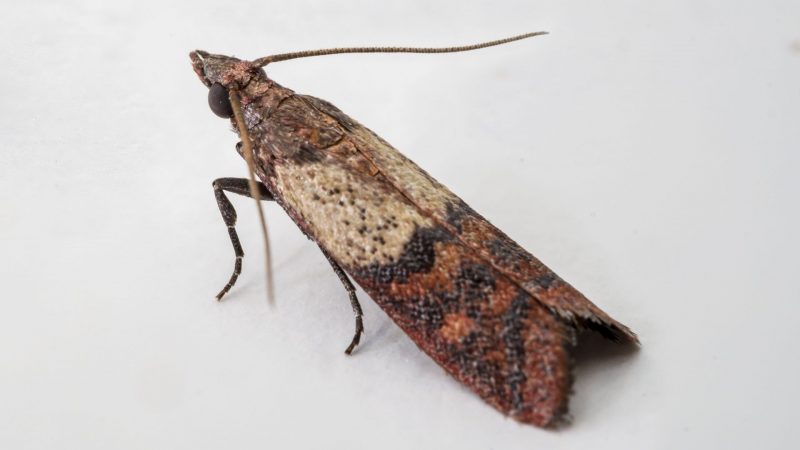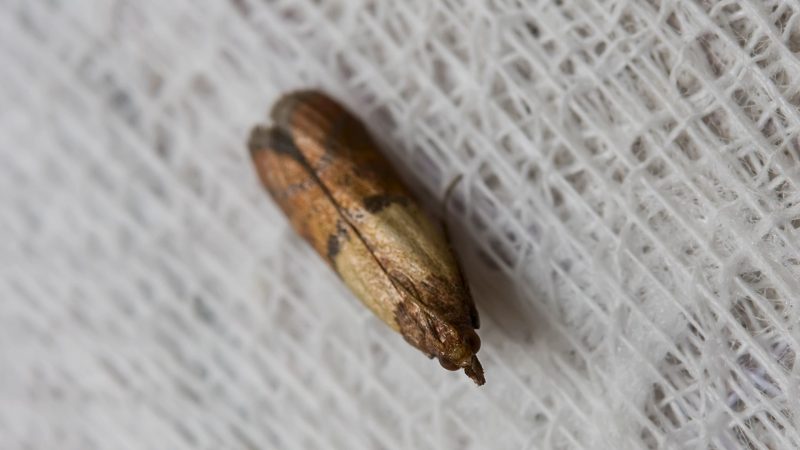You head towards the kitchen to prepare your favorite bowl of cereal. But as you opened its container, you saw some pantry moths crawling through the cereal grains. And at that specific moment, you have lost your appetite. Gross, isn’t it?
Here are the steps on how to get rid of pantry moths naturally:
1. Inspect the food items on your pantry for the presence of pantry moths.
2. Freeze or apply heat to the contaminated foodstuff.
3. Carefully scrutinize the grocery products you plan to buy, such as cereals, grains, dried fruits, and flour, before putting them inside the bags for weighing.
4. Store food in glass jars or metal canisters.
5. Keep your food supplies in cool and dry places.
6. Sanitize the areas where pantry moth infestation is prevalent.
7. Utilize moth traps such as sex pheromones.
What Are Pantry Moths?

Pantry moths are one of the most common pests that can be found on food pantries, homes, and farms. They have a scientific name of Plodia interpunctella and are also known as Indianmeal moth, grain moth, weevil moth, and flour moth. The larvae of these insects usually feed on grain products like oatmeal, flour, and cornmeal, seeds such as dried beans and birdseed, dried fruits like raisins, chocolates, nuts, and processed food products. Once they go out from their cocoons, they will transfer to other places in order to pass through the pupal stage.
What Do Pantry Moths Look Like?
The adult pantry moth is 5/8 inch in length. Its wings are reddish-copper colored on the outer two-thirds but off-white on the inner or body ends. On the other hand, their larva is whitish, 1/2 inch in length, and with a brown head.
What Is the Pantry Moth Life Cycle?

The life cycle of pantry moths is usually completed from 27 to 305 days. Adult females lay their eggs on the infested food item individually or in groups. These eggs are laid within 3 to 8 days, depending on the temperature of its surrounding. Once the eggs are hatched, larvae will look for food sources to eat. They progress in 21 to 70 days, and once they mature, they will search for other places to pupate. It may entail 15 to 20 days before they will reach the adulthood stage.
How Long Do Pantry Moths Live?
When you take into consideration the life cycle of these pests, it is believed that the pantry moths can live for three to four months. However, they may only live for 1 to 2 weeks if they cannot get proper food and nourishment.
Are Pantry Moths Seasonal?

Pantry moths have the capacity to reproduce all year-round, with up to seven or eight generations annually in some locations. Adult moths usually emerge from November to February, but the larvae may pupate in March and will achieve maturity in April during the winter season. Moreover, succeeding generations of moths typically follow as the seasons continue to change.
Where Are Pantry Moths Coming From?
Pantry moths are widely distributed in different parts of the world. They can withstand varying climates as long as they have a source of food. Other than that, these insects are nocturnal and have a great fascination with lights.
What Scent Do Pantry Moths Hate?
There are certain scents that pantry moths hate. They despise the smell of essential oils such as lavender and peppermint, vinegar, cedarwood, and herbs like thyme, rosemary, and clover. These repel and prevent them from rummaging through your pantry food.
What Are Pantry Moths Attracted To?
Pantry moths are great fanatics of food items with grains, dried fruits, and nuts. Therefore, if they see these supplies in your pantry, they will surely find a way to get through it. Also, they adore lights, so it could be a great enticement for these moths.
Are Pantry Moths Harmful?

Pantry moths are generally not harmful as they do not have the capacity to bite, injure or bring diseases to humans. They do not cause serious health issues but can be considered as an extreme nuisance in homes and farms.
How Do You Stop Pantry Moths?
Prevention is still the best remedy in stopping the spread of pantry moths. This can be done by inspecting your pantries and food containers for the presence of moth larvae. Once you see them lurking on it, you will need to discard or treat them to avert these tiny creatures’ growth.
Steps on How to Get Rid of Pantry Moths Naturally
1. Inspect the food items on your pantry for the presence of pantry moths.
As an old adage goes, “Prevention is better than cure”. Therefore, in order to avert the infestation of pantry moths, it is advisable to thoroughly assess your food products and containers for the presence of these kitchen pests. If you happen to see them in your storage, discard or treat the infested food items. Additionally, employ techniques in preventing the infestation of pantry moths by utilizing older products first.
2. Freeze or apply heat on the contaminated foodstuff.
If you observe pantry moths or their larvae on food supplies, freezing or applying heat can be an excellent strategy in deterring their presence. This can be done by freezing the affected items at 0 degrees Fahrenheit or heating them at 130 to 150 degrees Fahrenheit.
3. Carefully scrutinize the grocery products you plan to buy, such as cereals, grains, dried fruits, and flour, before putting them inside the bags for weighing.
Thoroughly assessing the products you bought lessens the possibility of bringing moth larvae inside your homes. This will also prevent incidents of pantry moth infestation in the long run. Aside from that, also inspect these items when you reach home before placing them in containers.
4. Store food in glass jars or metal canisters.
Pantry moths can easily chew on boxes and plastic bags. This is the reason why food products must be stored in glass or metal containers. These storage pieces must have tight covers and lids so that kitchen pests cannot enter inside them.
5. Keep your food supplies in cool and dry places.
Since these kitchen pests thrive in hot and humid areas, placing your food supplies in cool and dry places could be an effective control measure. Grocery items that are not consumed right away may be placed in refrigerators and freezers.
6. Sanitize the areas where pantry moth infestation is prevalent.
To prevent the further spread of these insects, you must clean the areas where pantry moth infestation is evident. You can wash the storage places with soap and water or vacuum the cabinets where the contaminated food products are placed. If there are food spills, make sure that it is cleaned and removed.
7. Utilize moth traps such as sex pheromones.
These are moth baits that take advantage of the chemicals emitted by female pantry moths. Male species are attracted and lured by these substances, so this is a helpful technique in knowing the spots where these pests are prevalent.
- Dr. Killigan’s Has Served More Than 1 Million Households —...
- End Pantry Moth Destruction — Dr. Killigan’s lab-proven,...
- Backed By Patented Technology — Dr. Killigan’s Proprietary...
- Easy to Use & Long-Lasting — Simply open, peel, fold and...
- Design Options — Dr. Killigan’s moth traps are also dressed...
Since we have already learned the useful techniques on how to naturally control the presence of pantry moths, get to know more of these kitchen pests by understanding their nature, traits, life cycle, and other valuable tips in deterring them.
What Products Eliminates Pantry Moths?
These are the products that effectively eliminate and exterminate pantry moths:
Pantry Moth Traps
Moth traps such as those from Dr. Killigan’s Store are ideal as pest baits. It consists of cardboard filled with glue and pheromones that can be bought in varying designs and styles. It must be placed in areas where a pantry moth infestation is believed to occur. Once these pantry moths are lured by the pheromones and decide to go on the cardboards, they will be trapped on it and probably die.
- Dr. Killigan’s Has Served More Than 1 Million Households —...
- End Pantry Moth Destruction — Dr. Killigan’s lab-proven,...
- Backed By Patented Technology — Dr. Killigan’s Proprietary...
- Easy to Use & Long-Lasting — Simply open, peel, fold and...
- Design Options — Dr. Killigan’s moth traps are also dressed...
Pantry Moth Sprays
If you desire to instantly eliminate pantry moths, using an insect spray could be an excellent strategy. Dr. Killigan’s Six Feet Under Insect Killer Spray could be the best option as it is harmless to apply and non-toxic. It does not contain pyrethrins, pyrethroids, permethrin, or other hazardous substances or scents, so it is safe to use inside the homes.
- 100% Plant-Powered Ingredients: Composed of essential oils and...
- Simple Application: Easily spray this effective, plant-powered...
- Kill Bugs Both on Contact & Residually: Six Feet Under is a...
- Highly Effective & Fast-Acting Formula: Protect your household...
- Eliminate Harsh Chemical Sprays & Unreliable Devices: This bug...
Frequently Asked Questions
Will Mothballs Keep Pantry Moths Away?
Although mothballs can be effective in getting rid of pantry moths, it is not advisable to use them around food pantries or preparation areas since they may pose some adverse health risks. However, it may be utilized to repel pantry moths when placed inside airtight food receptacles since the gases that would eliminate these pests would no longer escape.
Why Do I Keep Getting Pantry Moths?
You may be getting a lot of pantry moths due to your food supplies that are not covered or stored appropriately. These pests are intensely attracted to grains, cereals, dried fruits, and processed products so once they sense that these are readily available to them, they will surely find ways to get through it.
How Do Pantry Moths Get in Sealed Bags?
Pantry moths have the ability to penetrate bags that are made from plastic or paper materials. Thus, it is highly recommended to use glass or metal receptacles with tight covers in order to prevent these pests from invading your foodstuff.
Can Pantry Moths Fly in From Outside?
Pantry moths can fly in from outside. They will not hesitate in entering your house once they see open doors and windows, chimneys, broken crevices in the pantry, or unsealed food containers just to search and hunt for food.
Where Do Pantry Moths Hide During the Day?
Pantry moths would commonly lurk on food receptacles and containers during the day. The females would usually lay their eggs on these sites while the larvae do their best to extract nourishment from the food particles that can be found on them.
Do Pantry Moths Get Into Coffee?
Pantry moths can get into coffee. It is normal for these pests to invade coffee products such as coffee beans and coffee substitutes.
Summary
In conclusion, pantry moths can be a total nuisance for your pantries and kitchens. Once you give them the opportunity to enter these areas, they will not falter in devouring and contaminating your food. This is especially true for grain products, cereals, nuts, dried fruits, and processed products. Thus, always assess your pantries for a possible moth infestation.
Related: Top 10 Worst Pests That Can Infest Your House | Identification and Control Guide
List of Sources
Cranshaw, W. (2017). Indian Meal Moth – 5.598. Colorado State University.
Indian Meal Moth. (2021). University of Maryland.
Fasulo, T., Knox, M. (2018). Common Name: Indianmeal Moth. University of Florida.
Rutschky, C. (2017). Indian Meal Moth. The Pennsylvania State University.
Indian Meal Moth. Iowa State University.
- How to Get Rid of Turtles | Proven Long-Term Solutions! - August 26, 2023
- How to Get Rid of Kingsnakes | Easy & Humane! - August 26, 2023
- How to Get Rid of Northern Water Snakes | Best Solutions and Preventative Measures! - August 19, 2023


